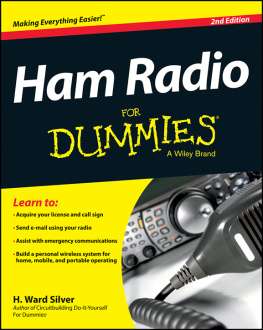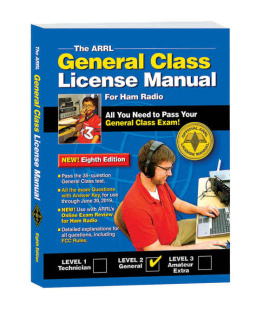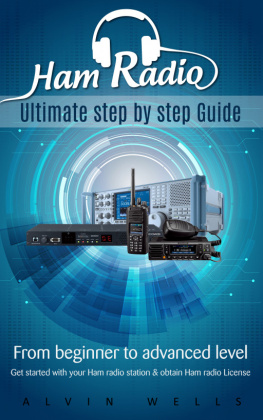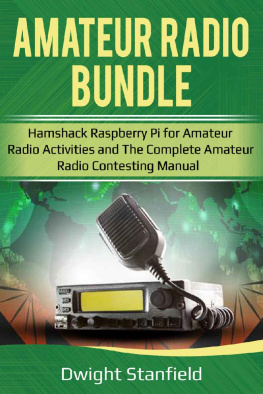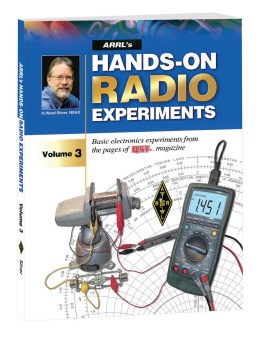
Ham Radio For Dummies, 2nd Edition
Published by: John Wiley & Sons, Inc. 111 River Street Hoboken, NJ 07030-5774 www.wiley.com
Copyright 2013 by John Wiley & Sons, Inc., Hoboken, New Jersey
Published simultaneously in Canada
No part of this publication may be reproduced, stored in a retrieval system or transmitted in any form or by any means, electronic, mechanical, photocopying, recording, scanning or otherwise, except as permitted under Sections 107 or 108 of the 1976 United States Copyright Act, without the prior written permission of the Publisher. Requests to the Publisher for permission should be addressed to the Permissions Department, John Wiley & Sons, Inc., 111 River Street, Hoboken, NJ 07030, (201) 748-6011, fax (201) 748-6008, or online at http://www.wiley.com/go/permissions .
Trademarks: Wiley, For Dummies, the Dummies Man logo, Dummies.com, Making Everything Easier, and related trade dress are trademarks or registered trademarks of John Wiley & Sons, Inc. and may not be used without written permission. All other trademarks are the property of their respective owners. John Wiley & Sons, Inc. is not associated with any product or vendor mentioned in this book.
Limit of Liability/Disclaimer of Warranty : The publisher and the author make no representations or warranties with respect to the accuracy or completeness of the contents of this work and specifically disclaim all warranties, including without limitation warranties of fitness for a particular purpose. No warranty may be created or extended by sales or promotional materials. The advice and strategies contained herein may not be suitable for every situation. This work is sold with the understanding that the publisher is not engaged in rendering legal, accounting, or other professional services. If professional assistance is required, the services of a competent professional person should be sought. Neither the publisher nor the author shall be liable for damages arising herefrom. The fact that an organization or Website is referred to in this work as a citation and/or a potential source of further information does not mean that the author or the publisher endorses the information the organization or Website may provide or recommendations it may make. Further, readers should be aware that Internet Websites listed in this work may have changed or disappeared between when this work was written and when it is read.
For general information on our other products and services, please contact our Customer Care Department within the U.S. at 877-762-2974, outside the U.S. at 317-572-3993, or fax 317-572-4002. For technical support, please visit www.wiley.com/techsupport .
Wiley publishes in a variety of print and electronic formats and by print-on-demand. Some material included with standard print versions of this book may not be included in e-books or in print-on-demand. If this book refers to media such as a CD or DVD that is not included in the version you purchased, you may download this material at http://booksupport.wiley.com . For more information about Wiley products, visit www.wiley.com .
Library of Congress Control Number: 2013938107
ISBN 978-1-118-59211-3 (pbk); ISBN 978-1-118-59220-5 (ebk); ISBN 978-1-118-59204-5 (ebk)
Manufactured in the United States of America
10 9 8 7 6 5 4 3 2 1
Introduction
Y ou may have come across ham radio in any number of ways. Maybe you browsed a website that has some ham radio content, such as a project on a do-it-yourself website or in a YouTube video. Hams also play key roles in movies such as Contact and on television series such as Last Man Standing, in which Tim Allen plays a ham who has stations in his basement and at work. Several cartoon characters on The Simpsons are hams, too! Youll discover hams and ham radio by reading about them in newspaper and magazine articles, by seeing them in action performing emergency communications services, by interacting with a teacher or professor, or maybe by talking to a friend or relative who enjoys the hobby. Interestingly enough, ham radio has room for all these activities. Ham radio includes a mad scientist or two, but most hams are just like you.
The traditional image of ham radio is of a room full of vacuum tubes, gears, flickering needles, and Morse code equipment, but todays hams have many more options to try. Although the traditional shortwave bands are certainly crowded with ham signals hopping around the planet, hams now transmit data and pictures through the airwaves; use the Internet, lasers, and microwave transmitters; and travel to unusual places high and low to make contact, even to and from the International Space Station.
Simply stated, ham radio provides the broadest and most powerful wireless communications capability available to any private citizen anywhere in the world. Because the worlds citizens are craving ever-closer contact and hands-on experiences with technology of all sorts, ham radio is attracting attention from people like you. The hobby has never had more to offer and shows no sign of slowing its expansion into new wireless technologies. (Did I say wireless? Think extreme wireless!)
About This Book
I wrote Ham Radio For Dummies, 2nd Edition, for beginning hams. If youve just become interested in ham radio, youll find plenty of information here on what the hobby is all about and how to go about joining the fun by discovering the basics and getting a license. Many books about ham radios technical and operating specialties are available, but this book introduces them briefly so you can get up to speed as quickly as possible.
If youve already received your license, congratulations! This book helps you change from a listener to a doer. Any new hobby, particularly a technical one, can be intimidating to newcomers. By keeping Ham Radio For Dummies handy in your radio shack, youll be able to quickly understand what you hear on the airwaves. I cover the basics of getting a station put together properly and the fundamentals of on-the-air behavior. Use this book as your personal radio buddy, and soon, youll be making contacts with confidence.
You can read this book in any order. Feel free to browse and flip through the pages to any section that catches your interest. The sidebars and icons are there to support the main story of each chapter, but you can skip them and come back to them later.
The book has five parts. Parts I and II are for readers who are getting interested in ham radio and preparing to get a license. Parts III and IV explain how to set up a station, get on the air, and make contact with other hams. Part V is the Part of Tens (familiar to all For Dummies readers), which presents a few tips and secrets of ham radio. The appendixes consist of an extensive glossary and a long list of excellent references both online and off for you to use as you branch out and expand your ham radio career.
Within this book, you may note that some web addresses break across two lines of text. If youre reading this book in print and want to visit one of these web pages, simply key in the address exactly as its noted in the text, pretending that the line break doesnt exist. If youre reading this book as an e-book, youve got it easy; just click the web address to be taken directly to the web page.
Foolish Assumptions
In writing this book, I made some assumptions about you. You dont have to know a single thing about ham radio or its technology to enjoy Ham Radio For Dummies, 2nd Edition, and you definitely dont need to be an electrical engineer to enjoy this book.

